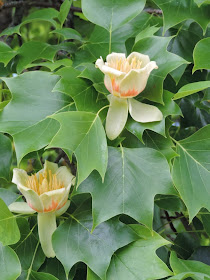Sheila and I went to the Royal Horticultural Society garden at Wisley on Saturday. It was beautiful - so many different plants were at their best, especially the roses.
There were a couple of areas of meadow, planted mainly with poppies to commemorate World War 1, but mixed with cornflowers and other annuals.
There were two or three tulip trees in flower around the garden - I am fond of tulip trees because of their interesting leaves, but I don't think I have ever seen one in flower.
And there were spectacular exotic plants in the glasshouse.
| Lobster claw - Heliconia rostrata |
This memorial is well-known to cemetery aficionados, but for the angel and its sculptor rather than for the person commemorated. (He made his money in coal-mining, and that's about all anyone wants to say about him, apparently.)
The local parakeets were very noticeable during the weekend, flying overhead and screeching. They are well-established by now around Twickenham and Richmond - quite handsome birds, although considered an alien pest.
Our friends' springer spaniel, Duke, is now fully-grown but as energetic and lively as ever.
As well as all these outdoors things, I spent a whole day in the British Library, reading issues of Woman's Weekly from 1914 to 1917. Such fun! All part of my research into knitting in the First World War (though I did get diverted by one of the romantic serials). More on that later.






















